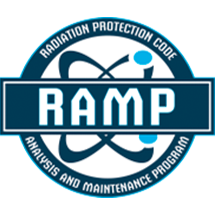Version 4.5.0
Released December 31, 2014
• Major Updates:
- RADTRAD re-coded in the Java computer language to work with all operating system platforms and the Symbolic Nuclear Analysis Package (SNAP) graphical user interface (GUI).
- Added the option for user to select the default time step option with error calculation. This option does not use adaptive time stepping, but does calculate error, and includes the estimated error plot variable to determine whether an adaptive time step solution is advisable.
- Added a reactor coolant system (RCS) activity calculator to the SNAP/RADTRAD Plugin-in to permit the calculation of radionuclide concentrations in the reactor coolant based on the ANS 18.1 Standard and the GALE-BWR and GALE-PWR computer codes. Pre-incident and co-incident iodine spiking is included in the model. Additionally, the RCS activity calculator allows the user to consider dose equivalent (DE) I1-31 and Xe-133.
- Added the ability for the user to model alternative source term (AST) non-LOCA DBAs described in Regulatory Guide 1.183 (RG 1.183). Accident scenarios include the fuel handling accident and a rod ejection (PWR) or control rod drop (BWR) accident. The DBA models based on the TID-14844 and the alternate source term in RG 1.183 are retained and the ability to consider a gap release from either RG 1.25 or RG 1.183 is also available to the user.
• Minor Fixes:
- Update the dose conversion factors (DCFs) to those provided in the Radiological Toolbox which are based on the DCFs compiled in FGR-11 and FGR-12. A total of 748 dose conversion factors are available in the SNAP/RADTRAD Plug-in.
- Updated and added larger radionuclide database from ICRP-38 (838 available nuclides). However, users should note that FGR-11 and FGR-12 DCFs are not available for all of the nuclides and the SNAP model editor will provide a warning if the user selects a nuclide for which no DCF is available. Users can input DCF data as needed.
- Plot variables were previously named based on the dose location number (e.g. “dose1.body”). These have been subsequently renamed based on the dose location name with spaces removed (e.g. “ExclusionAreaBoundary.body,” “ControlRoom.body,” and “LowPopulationZone.body”).
- Changes to the RADTRAD output files include:
- Previously the model description was printed to the output and NRC output file in the header to sections or at page divisions. Now the description is only printed at the start of the output file and the model ‘title’ is printed in the header to sections or at page divisions.
- The “Worst Two-Hour Doses” is printed as a time range rather than a single time value.
- The “Worst Two-Hour Doses” was removed from “Final Doses” since this information is already provided in the section just above “Final Doses.”
